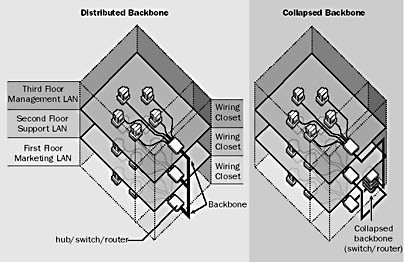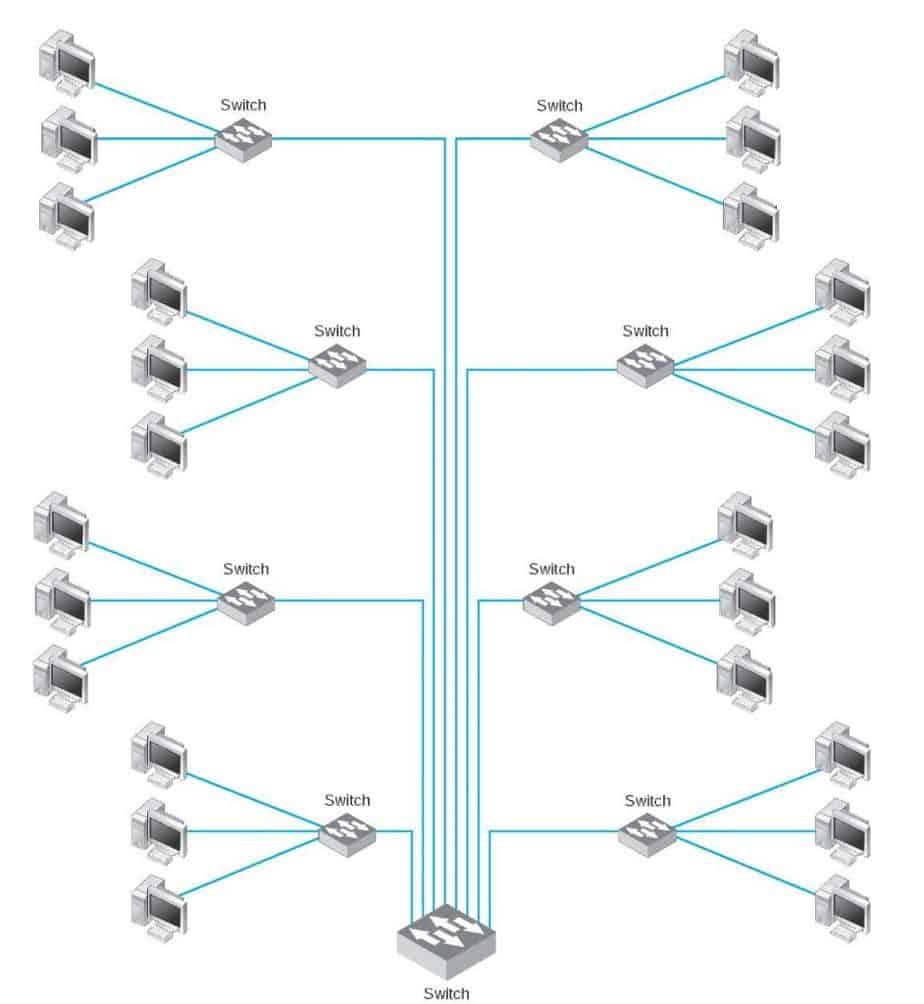Backbone in networking is the part of your network that ties different departmental networks into a single whole. The backbone carries the bulk of the network traffic and must be designed accordingly.

How does Backbone work?
Backbones are primarily used in medium to large-sized networks, such as those occupying a building or a group of buildings on a campus. These backbones generally fall into two basic categories:
Distributed backbone:
Refers to using cabling to join different departmental networks in a bus topology or mesh topology. This cabling is referred to as backbone cabling, and it connects the hubs, switches, or routers of each network into a single whole. In a typical scenario, each floor or building might have a local area network (LAN) and wiring closet containing, among other things, a main hub or router.
Backbone cabling is then run between floors or buildings, connecting the main hub or router for each department into a bus-style network (see illustration).
Collapsed backbone:
Refers to using cabling to directly join each departmental network’s main hub or router using backbone cabling to a central hub, switch, or router in a star topology (see illustration). The central unit is often referred to as the collapsed backbone, although this term properly describes the entire configuration. The central unit can be located in the building’s main equipment room or, in a campus scenario, in the IS department’s building.
Distributed backbones generally have a greater degree of fault tolerance than collapsed ones, because the collapsed backbone unit forms a single point of failure. However, collapsed backbones usually have better traffic flow than distributed backbones because of the underlying star topology. Collapsed backbones generally offer better performance because of the reduced number of hops that traffic must make when passing between departmental LANs.
Collapsed backbones are also easier to manage because they bring all the backbone switching and routing equipment into a single room or building. Collapsed backbones are used frequently for connecting departmental LANs within a single building, but less often for connecting building LANs across a campus network because of the increased distances and cabling costs.

Backbone cabling should have the highest bandwidth of any cabling in your network, since backbones are used to join together hubs, switches, and routers, linking departmental LANs or subnetworks into building-wide or campus-wide internetworks. In buildings, backbone cabling often refers to the vertical cabling running through the rises or elevator shafts that connects the hubs and switches in each floor’s wiring closet.
Depending on performance requirements, anticipated growth, and cost, any of the following might be suitable for backbone cabling:
- Cat5 UTP cable (get Cat5E 1000ft from Amazon)
- Type 1A STP cable (get Cat 7 Ethernet STP cable 50ft black)
- Thinnet coaxial cabling (get BNC Thinnet Coax Cable Black 50 feet)
- Multimode fiber-optic cabling (get Multimode duplex ST-ST fiber optic 2 meters)
- Single-mode fiber-optic cabling (get single-mode fiber optic cables)
Backbone as a collection of networking components
The term “backbone” is also used to refer to the collection of networking components (cabling, hubs, switches, and routers) that form the supporting network into which workgroup and departmental LANs are connected and joined together. A mesh topology is often used for network backbones to provide fault tolerance for critical high-speed data paths.
Design your backbone with network expansion in mind
You should put considerable thought and planning into the design and implementation of your network’s backbone, as the overall performance of networking services is largely dependent on the bandwidth and reliability of the backbone. Design your backbone with network expansion in mind. Planning for growth is especially important if the cable reinstallation cost is high. Fiber-optic cabling is preferred for most network backbones because of its high bandwidth, security, and resistance to electromagnetic interference.